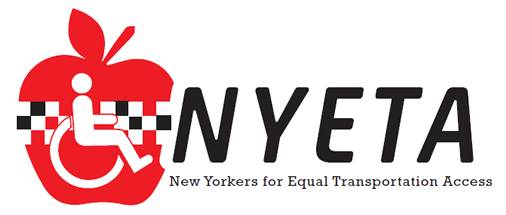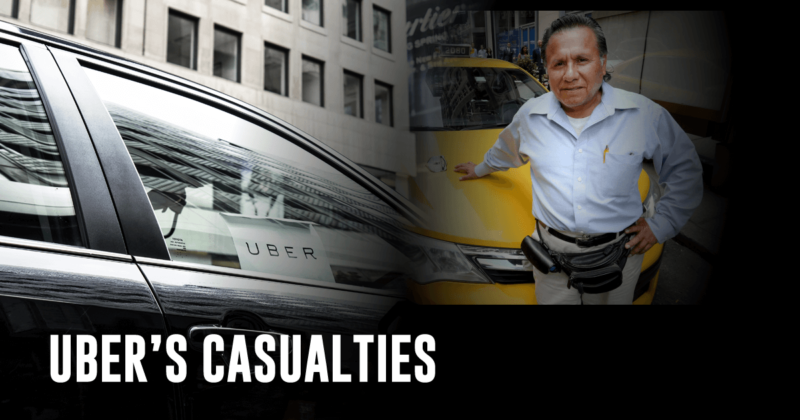From NY Post:
When Nino Hervias scraped together the down payment for a coveted yellow taxi medallion in 1991, he thought he had it all figured out.
Sure the hours were grueling, the city streets crime-ridden and the economy bleak — but he knew he was investing in his family’s future and believed it would afford him a comfortable retirement down the road.
He plunked down $118,000 for the medallion and watched its value soar — using it as backing for his family home in New Jersey while expecting it to also give his children a top-flight education.
“It was a good investment, on a yearly basis, averaging about 10 percent of the value, we were counting on that,” said the Peru-born Hervias, 57. “I told my kids I would give them each $200,000 for college.”
Hervias’ mortgage eventually swelled to $600,000 as he felt completely at ease using it to back his loans.
The value of the medallion hit $1.3 million in 2014 with no ceiling in sight.
But 25 years after making the purchase, that dream has become a nightmare.
Hervias’ medallion has plummeted in value with the surge of e-hail apps like Uber and Lyft — and he spends all of his waking moments behind the wheel, in an all-out war for passengers that requires jousting with umpteen other drivers.
“We are waking up in the middle of the night not knowing what our future is going to be,” said Hervias through tears. “This is my retirement. This is all I got. I have nothing.”
Taxis started appearing in New York City in the late 19th century in the form of electric hansom cabs. The industry slowly grew, and by the 1930s, it was like the Wild West, with more than 30,000 cabbies careening around the city unregulated.
In 1937, Mayor Fiorello La Guardia signed the Haas Act — introducing the medallion system in a bid to regulate an industry that was spiraling out of control.
The city initially sold 13,566 medallions for $10 each — about $166 in today’s money, or 7,831 times less than their peak value 77 years later.
By the end of World War II, there were 11,787 medallions in use, said TLC spokesman Allan Fromberg. That number stayed the same for over 50 years, until the city began increasing them by a few hundred at a time in 1997.
Along the way, the ubiquitous yellow cabs and their grizzled drivers became staples of the New York City streetscape.
Other than the Statue of Liberty, the canary yellow blaze of taxis might be the most iconic image of the city.
Who can forget Robert De Niro’s Travis Bickle plying the Big Apple’s blighted avenues in “Taxi Driver”?
For decades, taxi medallions were among the safest financial bets around. Many New Yorkers got rich by purchasing a few and watching their value soar over the years.
“From the 1930s until three years ago, it was the best-performing asset in the United States,” said Andrew Murstein, president of Medallion Financial Corp., the city’s largest financial backer of medallions.
His grandfather, Leon Murstein, was an upstart entrepreneur who bought one of the first medallions issued by the city. Over the next decade, he dropped every spare dollar he had into buying more medallions, and gobbled up 500 by the end of World War II.
By then, they were going for about $50. His family started leasing and then lending money to buy medallions, and today the company pulls in $27 million annually and trades on the NASDAQ.
“I would go to parties and people from Goldman Sachs would talk about their 12 percent returns, and medallions could easily beat that,” Murstein said.
Today there are 13,587 medallions — but yellow cabs are badly outnumbered by the onslaught of competitors. A total of more than 90,000 for-hire vehicles roam the streets, a number that spiked shortly after Uber entered the game in 2011.
The booming marketplace has done irreparable damage to the medallion.
Today, even if someone were willing to buy a medallion for a bargain basement rate of a few hundred thousands dollars, banks are now unwilling to back the sales.
“I know someone who was trying to sell for $400,000,” said cabbie Sergio Cabrera, who bought one in 2000 as a way to finance his golden years. “They had a buyer, but no one wanted to finance it, so the sale didn’t go through.”
Placida Robinson, who bought her medallion 10 years ago, still owes in excess of $840,000 on her loan, and for the first time in all her years driving, she is unable to make her payments.
The bank has started foreclosure proceedings, and she is now in danger of losing not only her medallion but also her apartment, and puts the blame squarely on the city for not protecting her and other taxi drivers’ investments.
She went to a recent TLC meeting and demanded that the city buy her medallion back from her at the price she paid for it plus interest.
“The city has its hand in the revenue grabbing on the back of medallions owners who were told this was an investment that they could own and control to be profitable,” said Robinson. “That’s not only a lie. It’s corruption.”
Meanwhile, the city has also felt the pain of Uber’s rise — with about 1,600 medallions sitting on the shelf unsellable. They would collectively have been worth more than $1 billion just a few years ago.
“The city has gone against the best interest of the taxpayers,” said Cabrera, who believes — along with many other yellow cab drivers — that more regulation is needed for the e-hail companies.
The crux of the argument is whether Uber and others are offering “on demand” service, which would violate the cabbies’ exclusive right to street hails.
Both state and federal courts have ruled that cars that pick customers up based on “e-hails” are prearranging rides, even if the car is cruising right by or just around the corner from the pickup spot.
But the furious yellow cabbies don’t see it that way.
“By allowing a company like Uber to come in and essentially do the same thing of on-demand service, they have gone against the contract that we had with them,” said Cabrera. “When someone uses the app to call for a cab, it’s the same as raising your hand in the street. This is why we paid hundreds of thousands and millions of dollars for these medallions, we thought the city would protect us.”
City officials say the court rulings show that it is regulating Uber as much as it has to.
“The issue has been litigated in state and federal court, and both found in favor of the TLC,” said agency spokesman Fromberg. “Plaintiffs are appealing both decisions and those appeals are pending.”
The impact is undeniable.
Thousands of yellow cabbies are in danger of losing their livelihoods, homes and retirement because the value of their taxi medallions has plummeted, and they are making little money, leaving them unable to pay off sky-high mortgages.
Drivers and lenders say the city has allowed Uber to turn the taxi industry into a veritable Lord of the Flies.
“Why would anyone want to pay for a medallion now when they can do the same exact thing without shelling out the money?” said Cabrera.
“I wouldn’t have bought mine if I had known the city was going to allow someone else to come in.”
Last summer, Mayor Bill de Blasio and the city council momentarily went toe to toe with Uber, proposing to severely limit the amount of new cars the app giant could add to city streets. But he quickly backtracked and the proposal was shelved.
There are other factors in the decline of the medallion — namely that the value was overinflated.
Taxi mogul Gene Freidman, who owns in excess of 860 medallions, more than anyone else in the city, has bragged about how he bought medallions for $1.3 million in 2013 to drive up the value of all the other ones he owned and make all of his investments look good.
The state had to take over another medallion lender, Montauk Credit Union, last year after the company tanked.
Murstein claims he saw the drop coming.
“Six years ago, we made the determination that the prices were too high,” said Murstein. “They were bound to fall. I believe that they have bottomed out now.”
Read more from The New York Post…


Recent Comments